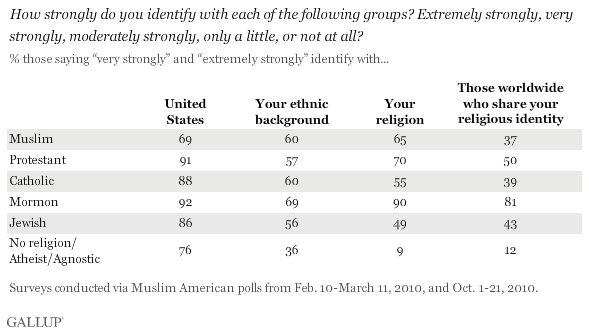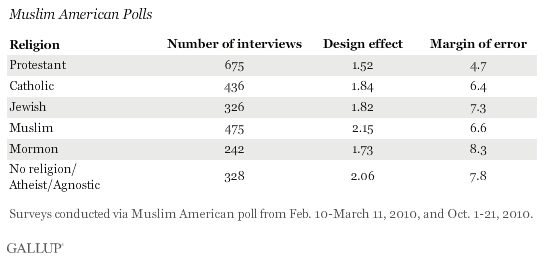WASHINGTON, D.C. -- Muslim Americans are equally as likely to identify with their faith as they do with the U.S. Muslim Americans are somewhat less likely than U.S. Protestants and Mormons to identify "extremely" or "very" strongly with the U.S.; however, 69% identify strongly with the U.S. and 65% identify with their religion.

These findings are among many featured in a new report released Tuesday by the Abu Dhabi Gallup Center, Muslim Americans: Faith, Freedom, and the Future, based on Gallup surveys conducted throughout 2010. Building on Gallup's early 2009 report on America's Muslim community, Muslim Americans: A National Portrait, this analysis tracks changes in Muslim Americans' attitudes since 2008, delves into current social and political research topics, and provides a series of data-driven policy recommendations.
The report reveals that Muslim Americans are also less likely than Protestant Americans to strongly identify with those worldwide who share their religious identity. In no major U.S. religious group studied is there a conflict between loyalty to the U.S. and identifying with others around the world who share the same religion. Rather, in every group, including Muslim Americans, people who identify extremely strongly with the U.S. are also more likely to identify strongly with their worldwide religious identity.
Muslim Americans With Strong Sense of Belonging More Likely to Be "Thriving"
The percentage of Muslim Americans who rate their lives high enough to be considered "thriving" has increased more over the past two years than that of any other major religious group in the U.S. A regression analysis sheds light on the traits most closely associated with thriving in every major religious group. Among U.S. Protestants, Catholics, Jews, and Mormons, a college education, a high level of religious observance (attending services at least once a week), and confidence in national security organizations such as the FBI are all predictive of thriving. These same traits plus a few others -- including strongly identifying with the U.S. -- are also predictive of Muslim Americans' likelihood to thrive.

U.S. Muslims who have a strong identification with the broader Muslim world, sometimes known as the Ummah, are more likely to be thriving. The connection between identification with the global Muslim community and thriving is somewhat stronger among Muslim American women than it is among men. In the case of Muslim Americans, the variables most likely related to thriving paint a picture of residents fully embracing their national identity and their faith.
Bottom Line
When examining the variables most closely associated with higher thriving rates for Muslim Americans, the degree to which thriving Muslim Americans demonstrate a sense of ownership and belonging to their country is noticeable. These respondents feel equally American and Muslim, attending religious services regularly while strongly identifying with the U.S. Further, their confidence in the FBI demonstrates that this group does not feel particularly or unfairly suspected by their government. It is also important to note that like other religious groups in the U.S., Muslim Americans' strong identification with those around the world who share their religious identity does not diminish their sense of national identity.
About the Report
Muslim Americans: Faith, Freedom, and the Future is based on a nationally representative study of Muslim American perceptions and the views of other major religious groups in the U.S. The report compares trends on Americans' life evaluations over the past three years as well as probes Muslim and non-Muslim perceptions on issues of national identity, terrorism, foreign policy, religious discrimination, and political participation.
For complete data sets or custom research from the more than 150 countries Gallup continually surveys, please contact SocialandEconomicAnalysis@gallup.com or call 202.715.3030.
Survey Methods
The first study of Muslim Americans was fielded via telephone to Muslim Americans and a nationally representative sample of adults in the U.S. aged 18 and older. The Muslim-American sample was selected from self-identified Muslim Americans who agreed to be recontacted after participating in the Gallup nightly polling. The general population sample included landline as well as cell phone-only respondents. The survey was administered from Feb. 10, 2010-March 11, 2010, and featured a five-call design. Because of the low number of Jewish American respondents in the sample of U.S. adults, an oversample of the Jewish population was performed using recontacts from the Gallup nightly polling. The data were weighted to correct for disproportionalities in probabilities of selection and response propensities. The data were then weighted to targets for age, gender, region, race, ethnicity, and education from the U.S. Census Bureau. Final weights were applied based on self-identified religious affiliation using targets from the Gallup nightly polling. The response rate for the study was 21%.
The second study of Muslim Americans was fielded via telephone to a sample of participants from each of the major religious groups. The sample for this study was selected based on self-identified religious affiliation of those who agreed to be recontacted from the Gallup nightly polling. The study featured a five-call design and had quotas of 200 for each major religious group other than Muslims. A random sample was chosen from eligible respondents of each of the major religious groups other than Muslims, while a census was taken of Muslim-American respondents. The survey was administered from Oct. 1-21, 2010. The data were weighted to correct for disproportionalities in probabilities of selection and response propensities. The data were then weighted to targets for age, gender, region, race, ethnicity, and education from the U.S. Census Bureau. Final weights were applied based on self-identified religious affiliation using targets from the Gallup nightly polling. The response rate for the study was 34%.
Results in the report are based on the aggregation of the two Muslim American polls, yielding a total sample of 2,482 adults, of which 475 self-identified as Muslims. The data in the combined file were reweighted to ensure the data were representative of the U.S. adult population and of the major religious groups. The margin of error is calculated at the 95% confidence level and is adjusted to reflect the design effect. In addition to sampling error, question wording and practical difficulties in conducting surveys can introduce error or bias into the findings of public opinion polls.

